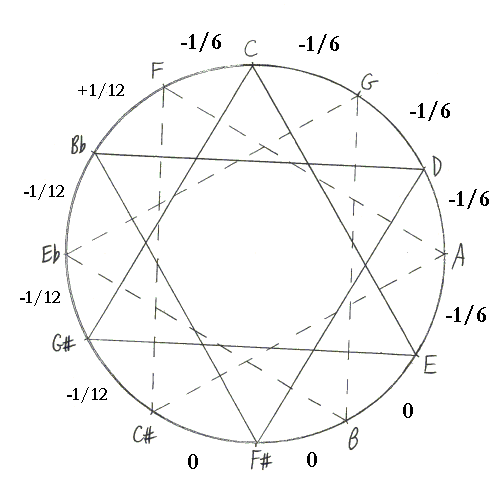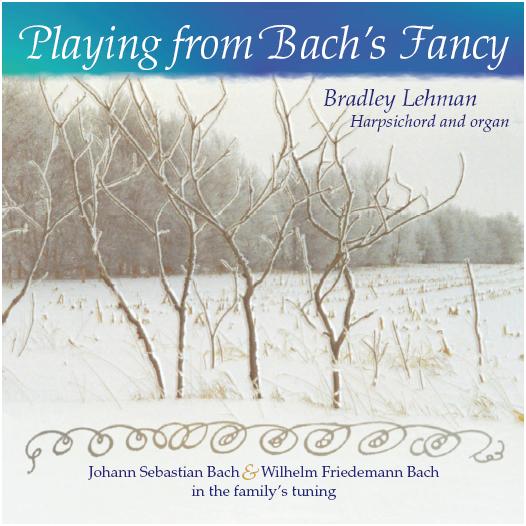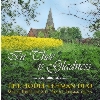
LaripS.com, © Bradley Lehman, 2005-22, all rights reserved.
All musical/historical analysis here on the LaripS.com web site is the personal opinion of the author, as a researcher of historical temperaments and a performer of Bach's music.
Practical "twang" instructions to set this Bach temperament by earThis explanation is especially for those whose concept of keyboard tuning is fixated on counting beats (as seen in countless modern books about temperament), or who would force Bach's diagram to be interpreted as prescribing any beats of one or two per second.Beats are important, yes; but the main principle here conceptually is interval quality. Please set the beat-counting aside for the moment! And forget the thinking in "cents" as that's a 19th century invention anyway. This page is about hearing amounts of spice in the sound.
7 July 2005, on the topic of "twang":
Since my harpsichord needed a fresh tonelift from
today's rain anyway, I tried the whole thing with no beat-counting
anywhere and did it only in terms of subjective "twang". No ratios,
no logarithms, no other maths, no
beat-matching of 3:2 or 1:1 or
otherwise, but just pretending not to understand any of the maths and
having a go, from experience with the sound. Worked out fine, and
the details are below.
The explanation (unavoidably?) had some maths anyway but I'm trying
to describe a process where the user doesn't need to understand them,
if learning it in practice at a keyboard.... Only the feeling of
single twang, double twang, and no twang.
Qualities of the 4th or 5th, working with the tuning lever in hand.
I agree with that observation, in the sense that musicians (whether
then or now) really don't need to understand logarithms in any
mathematical sense. What is important, however, is the concept of
"sameness" whether it's in a drawing or on a keyboard or in a
treatise.
Take, only for example, the common tuning of 1/4 syntonic comma
meantone
in its correct geometrical formulation. The eleven fifths
are all geometrically the same size, whether this is expressed by a
ratio or a logarithmic system or whatever. The diminished sixth
"wolf" is whatever is left over where the circle does not close. The
usable and correctly spelled triads all have exactly the same
character as one another, because the fifths (which happen to be
narrow) are all the same size, and the major thirds (happen to be
pure 5:4) and minor thirds (somewhat narrow) are likewise the same as
one another. The important thing is that sameness, which is
geometrical and is NOT beat rates.
Basic knowledge to practical musicians of the 18th century (I believe),
is how to set up whatever consistent variant of meantone suited
their taste, whether those resulting major thirds are pure or a
little bit wide or a little bit narrow...the correctly spelled major
thirds are the same size as one another, as are the correctly spelled
fifths that generate all 12 of the notes.
A basic harpsichord lesson
in tuning is knowing how much twang belongs in a 5th, to deliver some
overall quality when the whole layout is done. It's listening for
interval quality whether one is codifying that with beat rates or
not. After doing four 5ths in a row, test the resulting major 3rd
against the starting note to see if it sounds pleasant, by whatever
standard of expectation is in force. If not, start over by re-
twanging those 5ths until we get something we enjoy. And at each 5th
after that, test it against what we have already done (by a major
3rd) again to check pleasantness and sameness of quality. Keep going
until all 12 notes are done, and we're done. Basic tasteful
regularity, AKA "meantone" because the whole steps (e.g. C to D, and
D to E) end up being exactly halfway (mean) within whatever major 3rd
is in our taste. They have to be, because all 11 5ths are the same
size in generating them. A whole tone is simply two of these regular
5ths, transposed back by an octave.
Now, move on to the Bach drawing where (as we agree at least for
this) there are three of one single-looking thing, three of some other
empty thing, and five of one doubly-looking thing. And a surd off
one end or both, whatever's leftover after doing the main 11 by some
scheme. Without use of any logarithms whatsoever, but rather
thinking in ratios (so it's geometric rather than arithmetic), this
could be taken as adjusting three of the fifths by ratio X, adjusting
the next three as ratio Y, and the last five as ratio Z; and then
whatever surd in the diminished 6th off the end.
Let Y = 0 (i.e. pure 5th, no adjustment). Let X and Z be in some
relationship where the adjustment of Z sounds to a musical ear like
twice as much adjustment as X. Whether that's done by beat rates or
just from experience listening for a certain amount of twang in the
interval, there are three Xs the same as one another, and five Zs the
same as one another, and Z has twice the twang adjustment of X.
Historically, the process of widening some of the 5ths away from
their normal regular size (which here in this drawing is the five "Z" 5ths!) is called
temperament ordinaire. It is a process
using taste and experience. Some of the 5ths become less tempered (i.e. our "X" 5ths here),
some might even become pure (our "Y" 5ths) or wide (our leftover diminished 6th),
in that process of stretching
some of the sharps higher and/or some of the flats lower, so they
meet one another acceptably coming round the other side of the hill.
And Bach, not caring or even necessarily knowing about any numeric
values in ratios or logarithms, has written down here a practical
scheme to set up the twang in a way that works, having three
different sizes of 5ths (one size being pure, and two tempered), plus
whatever surd diminished 6th is hanging around.
One wouldn't even
have to know that these bits of twang are called fractions of commas;
but only how to do the thing, in sequence, in practice, working at an
instrument. No numbers, no logarithms, no ratios. It's a way to
adjust some common variant of regular (i.e. "meantone") layout,
tastefully with temperament ordinaire principle giving some of the
notes less twang than they would normally get in the cycle of
setting all 11 5ths in sequence.
Hence my hypothesis. Straight across the 5ths (doing all the white
notes first and then all the black notes, coming from the physical
layout of a keyboard), F-C-G-D-A-E-B-F#-C#-G#-D#-A#. If there's
something in the loop in the drawing, give it that amount of twang
narrow in the setting of that 5th.
It does not rely on any
numerical crunching or anything electronic;
it's just a practical method sitting at an instrument and doing the job,
as (I believe) Bach
would have done by taste and experience.
And having found something
nicely workable, whether it's by himself or somebody who taught it to
him, it's written down lest it ever get lost as a nice way to tweak a
regular "meantone" into something more usable for more music.
Beat rates
and other scientific measurement
are just our modern way of
getting it exactly the same from one occasion to the next, assigning
numerical values (whether they're frequencies or beats or something
logarithmic) to measure what has already been done intuitively and in
practice.
The starting pitch to do this in practice can be taken from any
convenient pitch source that plays a C, A, F, G, D, or E...since
those are all on the line of the regular 5ths. Or for that matter,
it's easy to take it from a B or an F# or a C# because those lead
back by pure 5ths to E and we're into the regular line.
So (sitting in Bach's chair in front of a harpsichord) we can
play any of these notes on whatever convenient instrument, like Jack
Shepherd's oboe d'amore that he bought in Hamburg last week and has
brought in to try with our harpsichord...play whatever note is most
central to the other ensemble instrument, tune the harpsichord string
to it, and then do the whole pattern outward in one or both
directions where we stop at F going one way and stop at A# going the
other way.
This is quite easy in practice, given that a specific
tempering shape on that temperament ordinaire is in mind.
(And here is my own practical sequence that
I use regularly, setting the instrument accurately by ear in under 15 minutes.)
The relationships of all these intervals stay the same, regardless of
what starting frequency we're handed by the other instrument built by
whatever nonstandard craftsman. The whole temperament moves up or
down together, constant shape, whether we call this "Cammerton" or
"Chorton" or "JackShepherdsOboeTon" or whatnot.
We are not limited to any single starting frequency, the way all the beat-insisters
are! The schemes of counting exactly one or two beats per second work only
in a particular octave, and only with a forced starting frequency where everything
will work out.
Sit down, do your 10
or 15 minute tuning at whatever the pitch du jour is, and play music.
Inside such a thought-process, listening for the quality or spice of the 5ths,
who cares about numbers? This is
about musical listening, and practical experience tuning harpsichords
at least a couple of times a week (putting ourselves into that 18th
century milieu of a working musician not having time or inclination
for mathematical calculation).
All the 16th-17th-18th century theorists who wrangled about various
numerical systems are all well and good, for their own amusement and
their own work. (Kirnberger too, added to that pantheon.) What
would need to be demonstrated here--by any proponents of the counting
of constant beats up the keyboard--is that Bach cared at all about
any of that theory.
Sit down at the keyboard, put the right amounts of twang into the appropriate
5ths (by experience and by being taught), and play music. No mathematical computations required.
I personally don't care a whole lot about the
math side of all that
either, except that it's a convenient language with which to explain
the musical results to mathematically-inclined people. My part in
this has been to try to translate the language of that shape in
Bach's drawing, to the more familiar language today of mathematical
concepts (whether that's commas or logarithms or frequencies or beats)...it's
all equivalency, and it's all merely measuring a concept
that is not itself limited to mathematical constructs.
In summary: This whole temperament can be set up quickly and
easily without counting any beat rates! One need only develop the skill
to sense accurately where several 5ths/4ths have the same amount of
tasty bite to them, and the experience to know how much of that is appropriate, and
where it belongs.
(This bite, technically, comes from the beats that give the interval
an appropriate wobble: not at a constant rate to be counted, but a constant
quality to be savored. The beats are there and that's what we are listening for,
but not with numbers or clocks.)
This same twang thing is also especially useful when setting octaves
carefully in the treble. Check each note for proper
twanginess with the 4th and 5th below the top note, as it's
being set. For example, checking the high octave G, if the C-G 5th
and the D-G 4th don't have the same twang, the G is too high or
too low to be a correct octave. And in testing an E it's supposed to
twang against the A but be pure to the B.
Bradley Lehman

|
v Introduction v Articles v FAQ > Practice - Hear samples - Tune it:Begin * Tune it:Interm - Tune it:Expert - Vocal music - Test pieces - Affekt tests - Organ 41 - Adventures v Theory v History v Etc v Recordings |




